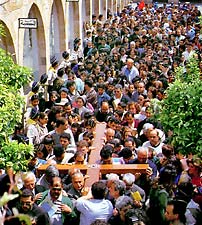 |
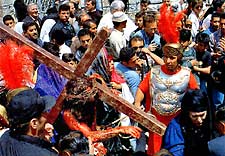 |
 |
 |
|
Photographs courtesy of Christus
Rex, Inc.
The Way of the Cross is not a work of erudition. It is essentially a devotional exercise, a means which men and women can use to make contact with God, to adore Him, to thank Him, to increase their love for Him. Devotion to the sufferings of Christ, is particularly recommended for all who wish to live "upon the model of that charity which Christ showed to us when he gave himself up on our behalf." Because the Passion was accomplished in a specific place, it is obviously important to know its geographical and physical layout. This includes the many changes the Holy Land has undergone since Gospel times, together with the buildings and churches that have risen over the actual spots, all of which could add to the confusion experienced by certain pilgrims. The road followed by Jesus on the day of his death has not escaped the vicissitudes of history; so we will not yield to the temptation of making stones the supreme arbiter in this matter. After all, it is by following the Way of the Cross that pilgrims have understood what the carrying of the cross was really like, through streets resembling those where crowds of people, often impassible, sometimes curious, still gather in front of the shops. (While the closing of the Moslem shops may be a help to piety, it has taken from the Friday procession the teeming crowds which were customary before 1967). Finally, what really matters is to follow Christ on the Way of the Cross of his Passion, as humble companions. The Stations "Via Dolorosa" or "Via Crucis" designates a stretch of road between the Antonia fortress and Golgotha, along which Jesus Christ walked bowed under the weight of the Cross. The name dates from the sixteenth century, although the custom of retracing Jesus' steps to Golgotha began in the early centuries of Christianity. According to the most common tradition the Antonia fortress and the Praetorium nearby were the sites where Jesus was brought before Pilate. The fortress, which stood near the north-west corner of the Jewish Temple, was the starting point for Jesus' painful walk toward Calvary, which at that time was outside the city walls. The Stations X through XIV are located inside the Church of the Holy Sepulchre. Since the middle of the last century, without interruptions, the Franciscans, Custodians of the Holy Places since the thirteenth century, carry out this devotion along the roads of the Old City of Jerusalem every Friday afternoon at 3:00pm (solar time). It is true that even prior to this date, since the middle ages the devotions towards the various "stations" was celebrated by the Friars and pilgrims alike. But there was also a period when the Franciscans were forbidden to perform any form of public prayer, including the Way of the Cross. The procession is lead by the Franciscan Custos of the Holy Land, or his representative. The Friars gather in the courtyard of El-Omari Madrasah (school of Islamic studies) from all the different friaries of Jerusalem, especially that of Saint Saviour. Accompanied by the "kawas" (a sort of bodyguard dressed in a Turkish costume) the procession winds up through the narrow streets of the city. Hundreds of pilgrims and local residents take part in this weekly public Christian manifestation in a city with a Moslem-Jewish majority. In front of each station the relative gospel or another scripture text is read accompanied by a prayer. It is performed in Italian and English all year round but during the Fridays of Lent, when the number of participants grow into the thousands, it is also performed in Arabic as the local Christian population has a particular devotion during these Fridays of Lent. Between each station hymns are sung, especially the Stabat Mater, and prayers are recited.
|
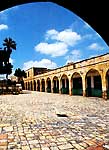 The
First Station - Here Jesus is sentenced to death. The
First Station - Here Jesus is sentenced to death.It is since the 16th century that the first Station of the Way of the Cross in Jerusalem is situated at this site where the Antonia Fortress stood. Most of the buildings go back to the first half of the 19th century and were used for a long time as barracks. The whole is of little architectural interest. Before 1927 the only elements on any importance was a construction erected in the southern wing identified as a medieval chapel. The site of el- Omariyye College is only one part of what tradition considered to be the Praetorium of Pilate. The other part took up the northern side of the street.
|
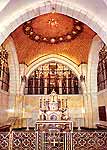 The
Second Station - Here Jesus is given the Cross. The
Second Station - Here Jesus is given the Cross.The place was only a mound of ruins, when in 1838, it was granted to the Franciscans by Ibrahim Pasha, conqueror of the Turks. Hastily rebuilt in the following year thanks to the generosity of Maximilian of Bavaria, the chapel was entirely restored in 1927-29 by A. Barluzzi, inspired here by the 12th century architecture. The three magnificent stained glass windows in the choir are the work of L. Picchiarini after the design of D. Cambellotti; they represent The Scourging, The Washing of Hands and The Triumph of Barabbas.
|
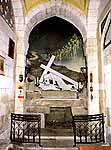 The Third Station - Here Jesus falls for the first time. On the site of a part of the former Turkish baths, on the left of the street coming from Damascus Gate, a chapel was built in the second half of the 19th century. This chapel was renovated in 1947-48 thanks to the generosity of Polish soldiers. The place belongs to the Armenian Catholic Patriarchate.
|
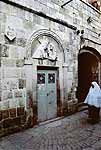 The Fourth Station - Here Jesus meets His Mother. The site of the chapel coincides with that of the former chapel known as "Chapel of the Fainting" mentioned by ancient pilgrims. The event of Jesus' meeting with his mother is not narrated in the Gospels but comes out of the pious tradition. The oratory is marked by a sculpture above the doorway by the Polish artist T. Zielinski.
|
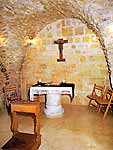 The Fifth Station - Here Simon the Cyrenian helps carry the Cross. All the Synoptic Gospels mention this event. There is a small Franciscan chapel at the corner where Tyropeon Valley turns toward the Market Road (on the right, in the east-west direction). This chapel marks the devotion of the Cyrenian helping Jesus to carry the Cross. |
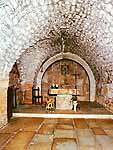 The Sixth Station - Here Veronica wipes the face of Jesus. A Greek Catholic Church preserves the memory of the meeting between Jesus and Veronica. According to tradition, Veronica wiped Christ's face with a silk veil on which His features remained imprinted. The holy relic of this meeting, Veronica's veil, has been kept since the eight century in Saint Peter's Basilica (Rome).
|
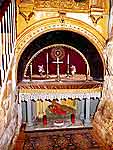 The Seventh Station - Here Jesus falls the second time. Inside the Seventh Station. The Franciscans took possession of this chapel in 1875 and they built over it two superimposed chapels. Within the chapel are the remains of a large column of red stone coming from the remains of the Tetrapylon of Aelia Capitolina.
|
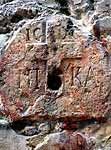 The Eighth Station - Here Jesus meets the Women of Jerusalem. A carved Cross marks the spot of the Eight Station. A stone embedded in the wall of the Greek, Monastery of Saint Haralambos has a Latin Cross and the Greek words "Jesus-Christ conquers." The site of the Eighth Station has been recorded at this spot since the middle of the 19th century when the Franciscans moved the commemoration site to beyond the "Judgement Gate."
|
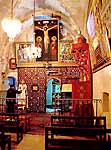 The Ninth Station - Here Jesus falls the third time. Interior of the Coptic Church of Saint Anthony next to the Ninth Station. The spot of Jesus' third fall as he neared Calvary was originally located in the courtyard of the Holy Sepulchre and it was marked by a stone with a cross engraved on it. The interruption of the Way of the Cross in the 16th century seems to have erased the memory of the original site. Later on, the current site was designated as the Ninth Station, in the immediate vicinity of the Church of Saint Anthony.
|
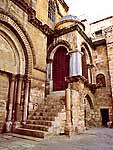 The
Tenth Station - Here Jesus is stripped of His garments. The
Tenth Station - Here Jesus is stripped of His garments.The Frankish Chapel in the Facade of the Church of the Holy Sepulchre. The spur of Calvary today lies within the Church of the Holy Sepulchre. When you enter the main door of the church a stairway on your right takes you to the spot where Jesus faced the death sentence. A great part of the platform of Calvary rests on an infrastructure. Only the eastern part rests directly onto the rock. The Tenth Station is located at the beginning of the nave on the right.
|
 The Eleventh Station - Here Jesus is nailed to the Cross. The altar of the Nailing to the Cross. This Latin nave was restored in 1937 by A. Barluzzi. The altar of silvered bronze is a gift of Ferdinand I de Medici. It is claimed to be the work of the Dominican Domenico Portigiani (1588) and was originally meant for the Stone of Unction. The altar panels represent the scenes of the Passion. |
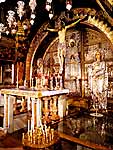 The Twelfth Station - Here Jesus dies on the Cross. The altar of the Crucifixion. Tradition places the erection of the cross and the death of Jesus in the eastern part of the nave on the left. A silver disk with a central hole, underneath the Greek Orthodox altar, marks the spot where the Cross stood. The site of the crucifixion has been fixed since Constantine's time when at this site he had erected a wooden cross replaced in 417 by the Emperor Theodosius II with another cross made of gold and precious stones.
|
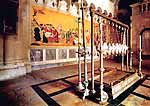 The
Thirteenth Station - Here Jesus is taken down from the Cross. The
Thirteenth Station - Here Jesus is taken down from the Cross.Coming down from Calvary, on the way to the Holy Sepulchre, in front of the main entrance of the Church, lies what has become known as the Stone of the Unction. In Jerusalem the scene of the taking down from the Cross was usually linked to that of the anointing, and located to the west of Calvary on the spot where, before the Crusaders, stood the Chapel of Saint Mary. The spot of the Anointing has been venerated since the end of the 13th century. The stone covers the rock on which the body of Jesus would have rested. Early pilgrims described this stone as black, green or white. Today it consists of a red polished block.
|
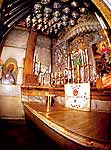 The
Fourteenth Station - Here Jesus is laid in the Sepulchre. The
Fourteenth Station - Here Jesus is laid in the Sepulchre.The actual sepulchral chamber is a small and awe-inspiring candle-lit space. A marble slab, laid there in 1555 by Fr. Boniface of Ragusa, Franciscan Guardian of Mount Sion, protects the rock of the tomb. Over the tomb, there are a great number of silver lamps, which belong to the three Christian denominations who share the property of the tomb: Catholic, Greek Orthodox and Armenian Orthodox. It is here that Christ completed His earthly mission before His glorious Resurrection in accordance with the prophecies.
|
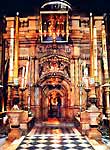 The Fifteenth Station - Here Jesus rises from the dead. The Aedicula of the Holy Sepulchre from where Jesus rose from the dead. "He told them, "This is what is written: The Christ will suffer and rise from the dead on the third day, and repentance and forgiveness of sins will be preached in his name to all nations, beginning at Jerusalem. You are witnesses of these things" (Luke 24:46-48). |
| Credits: All of the photographs used on this page are courtesy of Christus Rex, Inc. Used by permission of Michael Olteanu; images can not be used without written permission of Christus Rex, Inc - http://www.christusrex.org/ The Way of the Cross and descriptive text of The Stations by John Abela, ofm and Michael Olteanu; based on research by Albert Storm (SBF - Jerusalem). Text used by permission of Michael Olteanu; can not be used without written permission of Christus Rex, Inc - http://www.christusrex.org/ |